NCERT Class 11 Biology Chapter 15 Notes Plant Growth And Development- Download PDF Notes
Did you know that plants never stop growing throughout their life? The NCERT Class 11 Biology Chapter 13 Notes Plant Growth and Development explain difficult topics in clear language. This chapter talks about how plants grow, the role of plant hormones, and different stages of development. All the important concepts are explained in a detailed manner, along with well-labeled diagrams. Using the NCERT notes, students can learn important topics more effectively and perform well in school exams as well as in competitive exams like NEET.
This Story also Contains
- NCERT Class 11 Biology Chapter 13 Notes: Download PDF
- Class 11 Biology Chapter 13 Plant Growth and Development Notes
- Chapter 13 Plant Growth and Development Biology: Previous Year Questions and Answers
- How to Use Plant Growth and Development Class 11 Notes Effectively?
- Advantages of Class 11 Biology Chapter 13 Plant Growth and Development Notes
- Chapter-Wise NCERT Class 11 Notes Biology
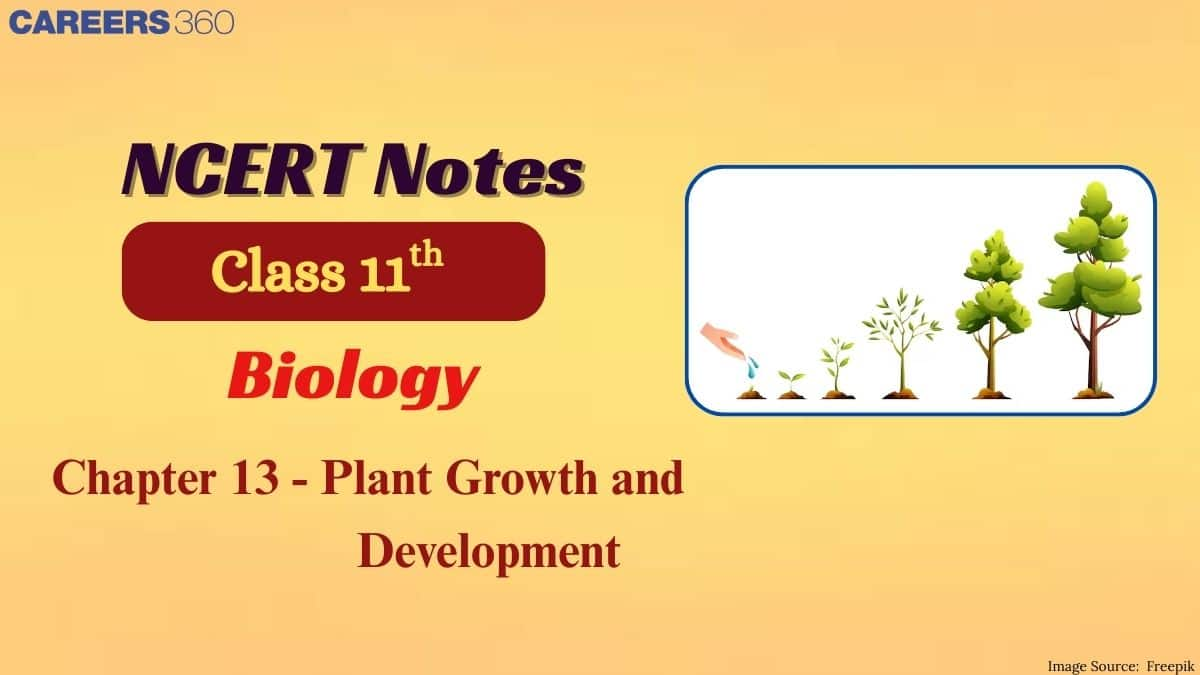
The Plant Growth and Development Class 11 Notes help students revise the important concepts in a very short time. Plant growth is an irreversible and permanent increase that occurs due to cell division, elongation, and differentiation. Development means the changes that help a plant grow, which is included in the NCERT Class 11 Biology Chapter 13 Notes. The NCERT notes for class 11 are well-organised and designed to support quick learning, which makes the exam preparation effective and efficient.
NCERT Class 11 Biology Chapter 13 Notes: Download PDF
Students can download the notes for Plant Growth and Development in PDF format from the link given below. By referring to the NCERT Class 11 Biology Chapter 13 Notes, they can understand topics like plant hormones and factors affecting growth, which is useful for both quick revision and daily study. The NCERT Notes for Class 11 Biology also help in remembering important diagrams and definitions for NEET.
Also, Read
Class 11 Biology Chapter 13 Plant Growth and Development Notes
Plant Growth and Development notes explain the important topics related to how plants grow and develop over time. Different concepts like growth phases, plant hormones, and seed germination. The Plant Growth and Development Class 11 Notes are simple, clear, and follow the latest NCERT curriculum.
Plant Growth And Development
Growth is an irreversible, permanent increase in an organ's size, one of its parts, or even a single cell's size is referred to as growth. Generally, it is accompanied by metabolic processes (both anabolic and catabolic) that occur at the cost of energy. Therefore, for example, the expansion of a leaf is growth.
Growth
Growth in plants refers to an irreversible increase in size, volume, or mass due to cell division and enlargement throughout life and is observed in various structures such as roots, leaves, and flowers. It is influenced by both internal and external factors. Unlike animals, plant growth is continuous and occurs at a specific region, such as the Meristems. This dynamic process helps plants adapt to environmental changes and ensure survival and reproduction.
Plant Growth Generally Is Indeterminate
Unlike animals, plants exhibit indeterminate growth, meaning they continue growing throughout their lifespan. This is due to the presence of meristematic tissues at the shoot and root tips, which divide continuously to produce new cells. Some parts, such as leaves and flowers, exhibit determinate growth, meaning the growth with a specific size, but structures like roots and stems maintain the growth potential infinitely, allowing plants to regenerate and adapt efficiently.
Growth Is Measurable
Since growth involves an increase in size and mass, it can be measured quantitatively by various parameters such as length (stem elongation), volume (fruit expansion), surface area (leaf expansion), and dry weight (biomass accumulation) to help assess plant growth. Instruments like auxanometers measure shoot elongation, while dry weight estimation provides insights into overall biomass production. Growth measurement helps in studying plant responses to different environmental and genetic factors.
Phases Of Growth
There are 3 broad phases of growth, namely, the meristematic phase, the elongation phase, and the maturation phase.
The meristematic phase has actively dividing cells that are present at the root and shoot tips.
The elongation phase has newly formed cells that increase in size due to water absorption, protoplasm expansion, and cell wall modification.
In the maturation phase, the cells differentiate into specialised tissues like the xylem and phloem, achieving their final functional form.
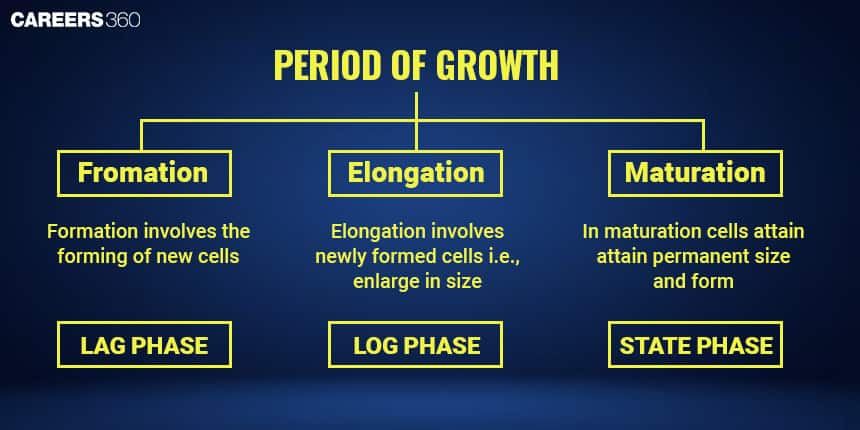
Growth Rates
Growth in plants can be classified into arithmetic and geometric growth, both of which describe how plant cells divide and expand over time. In arithmetic growth, one daughter cell continues to divide while the other is divided into specialised tissue and stops dividing. This type of growth is linear and constant over time, leading to a steady increase in size. In geometric growth, both daughter cells retain the ability to divide, leading to exponential growth. Initially, growth is slow (lag phase), followed by a rapid increase (log phase), and finally, growth slows down (stationary phase) as nutrients or space become limiting.
The mathematical form of Arithmetic and Geometric Growth is explained below-
$L_t = L_0 + rt$
$L_t$ = length at time t
$L_0$ = length at time zero
$r$ = growth rate or elongation per unit time
The exponential growth can be expressed as:
$W_1 = W_0 e^{rt}$
$W_1$ = final size (weight, height, number, etc.)
$W_0$ = initial size at the beginning of the period
$r$ = growth rate
$t$ = time of growth
$e$ = base of natural logarithms
Growth Between Organs Can Be Compared Either In:
Absolute terms, i.e., total growth in unit time, or,
Relative terms, i.e., growth of the system per unit time expressed on a common basis.
Conditions for Growth
Plant growth depends on both internal and external factors. There are various factors affecting plant growth. The internal factors, such as genetic makeup, hormones, and metabolic activity, regulate growth and development. They can either help in the development or inhibit the growth. External factors such as light, temperature, water, oxygen, and nutrients are essential for various plant processes, such as photosynthesis, respiration, and cell division. The optimal conditions ensure that healthy plant development, flowering, fruiting, and seed production are achieved.
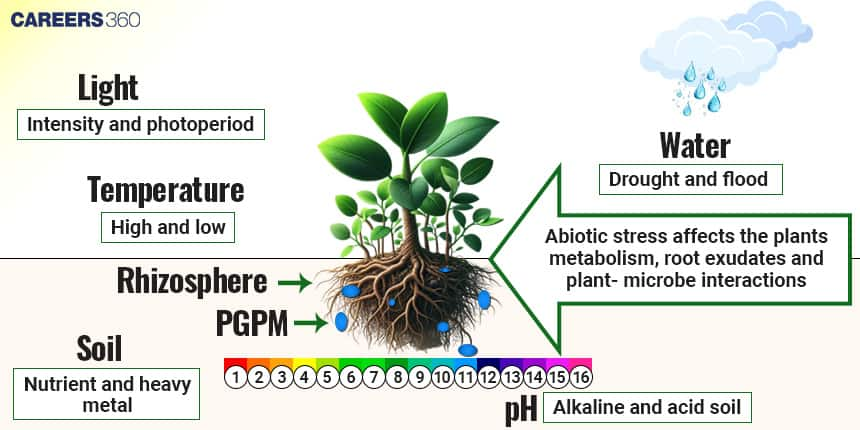
Differentiation, Dedifferentiation, and Redifferentiation
The processes are explained below-
Differentiation
Differentiation is the process by which unspecialised cells develop into specialised tissues like xylem, phloem, and epidermis. It is important for plant structure and function, enabling efficient transport of nutrients and water. Cells undergo morphological and physiological changes to perform specific roles, ensuring overall plant efficiency.
Dedifferentiation
Dedifferentiation occurs when mature specialised cells revert to an undifferentiated state to regain the ability to divide. For example, parenchyma cells transform into meristematic cells to form vascular cambium. This ability allows plants to repair injuries, regenerate lost parts, and sustain secondary growth.
Redifferentiation
Redifferentiation is when previously differentiated cells regain their specialised function. For example, the vascular cambium for secondary xylem and phloem during secondary growth. This process is important for regeneration, healing wounds, and producing new tissues and mature plants.
Development
Development in plants includes all changes from germination to senescence, involving growth, differentiation, and reproduction. It is controlled by various factors such as genetic, environmental, and plant hormones. The developmental process includes seed, germination, flowering, fruiting, and ageing, ensuring the plant completes its full life cycle.
Plant Growth Regulators: Auxins, Gibberellins, Cytokinins, Abscisic acid, Ethylene
The characteristics of different plant hormones are given below-
Characteristics:
Plant growth regulators (PGRs) are chemical messengers that regulate growth and development. They can be growth promoters, such as auxins, gibberellins, and cytokinins, or growth inhibitors such as abscisic acid and ethylene. These hormones influence processes such as cell division, elongation, flowering, dormancy, and stress responses.
The Discovery of Plant Growth Regulators
The Discovery of all 5 major PGRs was by chance.
Charles Darwin and Francis Darwin conducted experiments on coleoptiles of canary grass and observed that the tip of the coleoptile was responsible for bending towards light. Therefore, the hypothesis is that a chemical signal was transmitted from the tip of the flower to the lower part of the plant. Went then isolated this growth-promoting substance from the coleoptile and named it auxin.
Elichi Kurosawa was a scientist studying the foolish seedling disease in Rice plants. This disease is caused by the fungus Gibberella fujikuroi, which leads to the excessive elongation of rice seedlings. Yabuta and Sumiki isolated the active compound responsible for this abnormal growth and named it Gibberellins.
Skoog and Miller discovered a growth-promoting substance while studying the effect of coconut milk and yeast extract on tobacco pit cells. They identified the first cytokinin, called kinetin, from the herring sperm DNA.
Addicott and colleagues identified growth-inhibiting hormones in leaf abscission and seed dormancy. They named abscisic acid because it was first associated with leaf abscission.
Dimitry Nelijubov discovered that ethylene gas released from burning gas lamps caused the triple response in plants,i.e., elongation of seeds, swelling of stems, and horizontal growth instead of vertical growth. Then, R. Gane, in 1934, confirmed that ethylene is a naturally occurring plant hormone responsible for fruit ripening, leaf abscission, and senescence.
Physiological Effects of Plant Growth Regulators
Auxins
Auxins are growth-promoting hormones that regulate elongation, root initiation, and apical dominance. They are mainly synthesised at shoot tips and young leaves and promote phototropism and gravitropism. They promote cell elongation, apical dominance, and vascular differentiation. They are also used in tissue culture, fruit development, and weed control.
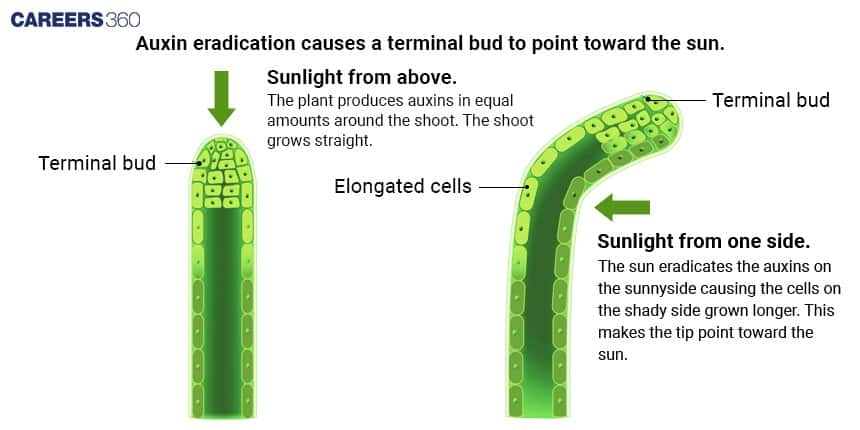
Gibberellins
Gibberellins stimulate cell elongation, germination, fruit development, and seed dormancy and promote flowering in the Long-Day plants. Long plants are the kind of plants that require a longer duration of sunlight than normal plants. They also stimulate cell elongation, seed germination, and bolting in rosette plants. They also break seed dormancy and enhance fruit size and yield.
Cytokinins
Cytokinins are plant hormones that promote cell division, delay leaf senescence, and enhance shoot growth. They work in coordination with auxins to regulate root and shoot development. Naturally occurring cytokinin is zeatin, found in young fruit seeds and roots. Synthetic cytokinins like kinetin are used in plant tissue culture.
Ethylene
Ethylene is a gaseous hormone that regulates fruit ripening, leaf abscission, and stress response. It also promotes seed germination and flowering. It is widely used in commercial agriculture to promote fruit ripening and ensure flower longevity.
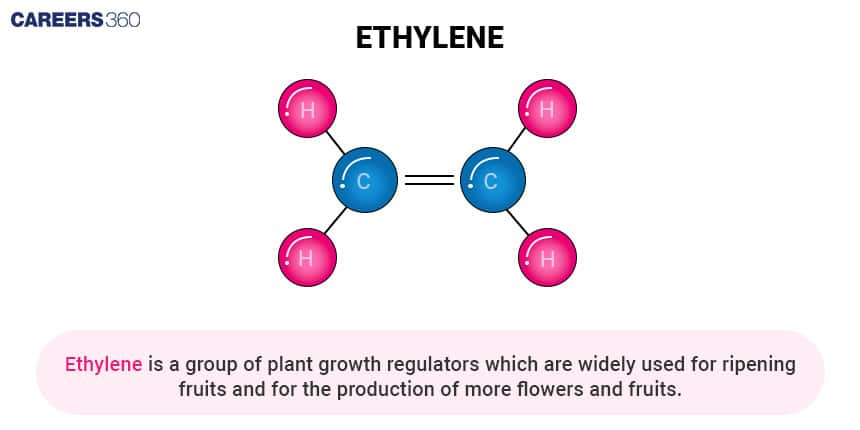
Abscisic Acid
Abscisic Acid is a stress hormone that helps plants survive unfavourable conditions by inducing seed dormancy, closing stomatal pores to prevent water loss, and regulating leaf abscission. It plays an important role in drought resistance by signalling the closure of stomata during water deficiency.
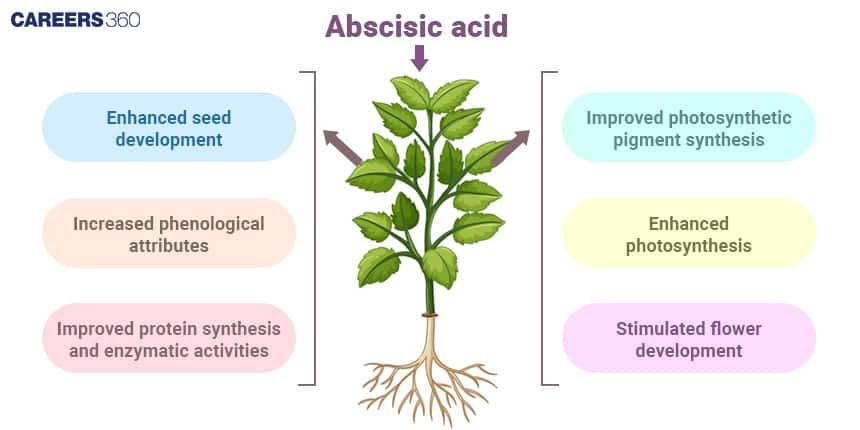
Also, Read
Chapter 13 Plant Growth and Development Biology: Previous Year Questions and Answers
Solving past year questions from this chapter, which are given below, helps students understand the topic better. Students can use the NCERT Class 11 Biology Chapter 13 Notes Plant Growth and Development to prepare well for exams.
Question 1. Monocarpic plants are those that
Option 1. Bear flowers with one ovary
Option 2. Flower once and die
Option 3. Bear only one flower
Option 4. All of the above
Answer:
Flowering plants that only produce flowers and seeds once in their lifespan before dying are known as monocarpic plants. The Greek terms monos, which means "single," and karpos, which means "fruit," are the origin of the word "monocarpic." Examples of monocarpic plants are Bamboo, Banana, etc.
Hence, the correct answer is option (2), Flower once and die.
Question 2. Growth can be measured in various ways. Which of these can be used as parameters to measure growth?
Option 1. Increase in cell number
Option 2. Increase in cell size
Option 3. Increase in length and weight
Option 4. All the above
Answer:
Generally speaking, plant growth is indeterminate; plants can continue to develop for the duration of their lives. This is because specific parts of their bodies contain meristems, which can divide and reproduce themselves. Growth is Measurable: Growth at the cellular level results from an increase in protoplasm, which is hard to quantify. Plant growth is quantified using a variety of techniques, such as a rise in fresh weight, volume, dry weight, or cell number.
Hence, the correct answer is option (4) All the above
Question 3. Ethylene is used for
Option 1. Retarding the ripening of tomatoes
Option 2. Hastening the ripening of fruits
Option 3. Slowing down the ripening of apples
Option 4. Both b and c
Answer:
Ethylene is a naturally occurring hormone within fruits that monitors the ripening of the fruit by inducing and regulating many chemical and biochemical activities. Fruit Ripening: In climacteric fruits such as apples, bananas, tomatoes, etc., exposure of mature fruits to ethylene results in respiration climacteric followed by additional production of ethylene, leading to the hastening of the ripening process.
Hence, the correct answer is option (2), hastening the ripening of fruits.
Question 4. Which plant hormone is primarily responsible for cell elongation in stems?
Option 1. Cytokinin
Option 2. Auxin
Option 3. Abscisic acid
Option 4. Ethylene
Answer:
Auxins are key growth hormones that promote cell elongation, especially in stems and young shoots. They loosen the cell wall, allowing cells to stretch and expand. This process helps in phototropism and geotropism in plants, enabling them to bend toward light or grow against gravity.
Hence, the correct answer is option (2), Auxin
Question 5. Vernalisation is the process by which
Option 1. Seeds break dormancy
Option 2. Plants require exposure to low temperatures to flower
Option 3. Plants respond to day length to flower
Option 4. Fruits develop without fertilisation
Answer:
Vernalisation refers to the induction of flowering by prolonged exposure to low temperatures. This treatment ensures that plants flower at the correct time, usually in spring. Biennials like cabbage and carrot require vernalisation to transition from the vegetative to the flowering stage.
Hence, the correct answer is option (2). Plants require exposure to low temperatures to flower.
Also Read:
How to Use Plant Growth and Development Class 11 Notes Effectively?
Plants undergo a series of changes from germination to maturity, adapting to environmental conditions and internal signals.
Understand how different plant hormones influence cell division, elongation, and differentiation to know the developmental processes.
Use Class 11 Biology Chapter 13 Plant Growth and Development Notes PDF to revise the types of growth, phases of development, and their significance.
Study the effect of environmental factors like light, temperature, and water on plant growth.
Refer to Class 11 Biology Chapter 13 Plant Growth and Development Notes to understand the use and examples of plant growth regulators.
Advantages of Class 11 Biology Chapter 13 Plant Growth and Development Notes
Studying through the well-organised notes helps students understand how plants grow, differentiate, and respond to their environmental surroundings.
- Class 11 Biology Chapter 13 Plant Growth and Development Notes PDF provides a clear summary of concepts like growth phases, differentiation, dedifferentiation, and redifferentiation.
- Using the notes regularly saves a lot of time and allows students to connect the concepts of this chapter with plant physiology topics.
- Important definitions and differences are clearly highlighted for quick revision before school exams and competitive exams like NEET.
- Students can also improve their visual memory and better retention of concepts by going through the notes.
Chapter-Wise NCERT Class 11 Notes Biology
Given below is a table that includes notes on each chapter included in Class 11 Biology. Students can use them for quick learning and effective exam preparation.
Frequently Asked Questions (FAQs)
Growth is an irreversible, permanent increase in size. This can take place at the cellular, tissue, or organ level, whereas development is the sum of two independent phenomena of growth and differentiation, as explained in the NCERT Class 11 Biology Chapter 13 Notes Plant Growth and Development.
Cells that have lost their dividing capacity restart dividing under certain conditions. This phenomenon is called dedifferentiation, according to the NCERT Class 11 Biology Chapter 13 Notes Plant Growth and Development.
Auxins, Gibberellins, and Cytokinins are growth-promoting phytohormones.
Gibberellins, a group of plant hormones, play a crucial role in seed germination by breaking dormancy, stimulating the production of hydrolytic enzymes, and promoting cell elongation and growth of the embryo.
Abscisic acid (ABA) is a plant hormone that plays a crucial role in regulating plant growth, development, and responses to stress, particularly by inducing seed dormancy, closing stomata to conserve water, and promoting leaf senescence.
Plant growth and development are influenced by both internal (genetic and hormonal) and external (environmental) factors, including light, temperature, water, nutrients, and soil conditions.
Ethylene, a plant hormone, is a key regulator of fruit ripening, triggering changes in texture, color, and flavor, and ultimately leading to senescence (aging).
Courses After 12th
Applications for Admissions are open.
As per latest syllabus. Physics formulas, equations, & laws of class 11 & 12th chapters
JEE Main Important Chemistry formulas
Get nowAs per latest syllabus. Chemistry formulas, equations, & laws of class 11 & 12th chapters
JEE Main high scoring chapters and topics
Get nowAs per latest 2024 syllabus. Study 40% syllabus and score upto 100% marks in JEE
JEE Main Important Mathematics Formulas
Get nowAs per latest syllabus. Maths formulas, equations, & theorems of class 11 & 12th chapters
